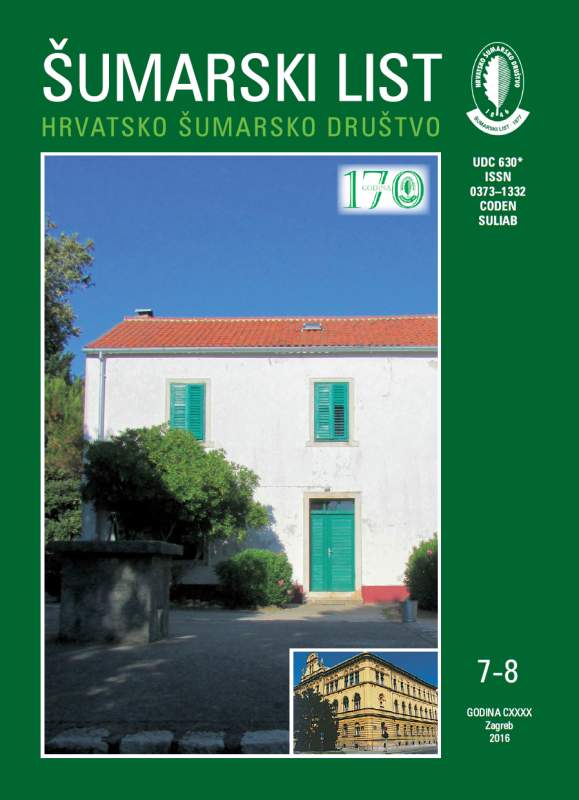
broj: 7-8/2016
pdf (13,65 MB) |
|
||||||||||||||
| RIJEČ UREDNIŠTVA | ||
| Uredništvo | ||
| WHO DECIDES WHAT IS SCIENCE AND WHAT IS NOT SCIENCE? pdf HR EN | 325 | |
| IZVORNI ZNANSTVENI ČLANCI | ||
| Damir DRVODELIĆ, Milan ORŠANIĆ, Vinko PAULIĆ | UDK 630* 164 (001) | |
| IMPACT OF ECTOMYCORRHIZA AND HUMIC ACIDS ON MORPHOLOGICAL FEATURES OF 1 YEAR OLD SEEDLINGS OF Paulownia tomentosa x Paulownia fortunei HYBRIDS pdf HR EN | 327 | |
| Kristijan TOMLJANOVIĆ, Ante SELETKOVIĆ, Maja MALNAR, Marijan GRUBEŠIĆ | UDK 630* 156 (001) | |
| AN ERROR ANALYSIS OF HUNTERS IN ESTIMATING THE TARGET DISTANCE pdf HR EN | 339 | |
| SUMMARY Depth perception is the ability to see thre dimensional volume and special layout of objects in relation to one another as well as to the observer himself. This depth perception in humans is achieved by different signs in nature where the eyes or the brain relies on certain regularities in the environment (Watson & Enss 2012). Knowing the size of the object from previous experience our brain can calculate distance based on the size of the object on the retina (Abel 2014). For proper depth perception it is necessary that both eyes focus the object synchronously. This way, observing the object simultaneously from two different angles a plastic image of the object is create in the brain (Tran and ass., 2010), and all other information on the observed object is being given (Greene & Oliva 2009; Oliva & Schyns 2000; Rousselet i sur., 2005; Sanocki 2003). In everyday hunting management proper assessment of distance of wild game, especially of big game species, is of crucial significance in executing cull. Most rifles that are now used for cull are equipped with optical sights that are generally calibrated at 100 – 150 meters. Depending on the calibre, height of the optics, bullet weight, distance and angle from which you shoot, as well as some other less important parameters, depends the success of the cull itself and punctuality of the shot.Often is the case that the reason for missing in cull attempts should be looked for in the wrong assessment of distance of wild game. Distance assessment of objects in nature has been researched on the sample of 40 hunters of different age groups, hunting experience and education. Research has been conducted in three types of habitat, lowland (up to 200 a.s.l.), highland (200 – 800 a.s.l.) and mountain (over 800 a.s.l.).To eliminate biases each hunter has been tested in ten differently distanced objects. Measurement control has been conducted with laser telemeter. Conducted research was supposed to determine that the bias distance assessment depends on different factors. As expected, by increasing the distance of the object for which distance was assessed, the distance assessment error also increased. It was determined that age has influence on distance assessment and assessment error that occurs. In youngest and oldest hunters the biggest average error has been noticed, while somewhat smaller errors have been noticed in hunters in the age group of 40 to 60. It can be therefore assumed that the errors in the group of younger hunters is the result of insufficient experience, while in the group of hunters above 60 years of age this is the result of reduced functionality. Hunters that are older than 70 have shown on average smaller error than the ones in age category 60 – 70 years of age, however considering that it is a small sample and dissipation is far bigger this part of the sample should not be considered relevant. This situation does not correspond to the errors that were noticed in analysing errors in correlation with hunting experience, especially when you take into account that hunting experience increases proportionally with age. Most errors were done by hunters with hunting experience between 10 and 20 years. Hunters that were hunting for less than ten years made less mistakes on average and therefore these results are also in favour of the thesis that for distance assesment hunting experience is less important, and that sight functionality and life age are crucial. Analysis of level of education show that the hunters with higher education made less errors. All hunters on average estimate smaller distance that the measured one. By increasing the distance the error in distance estimation is also increased. Key words: estimation of distance; hunters; hunting management; habitat | ||
| Vladan POPOVIĆ, Ivona KERKEZ | UDK 630* 164 + 165 (001) | |
| POPULATION VARIABILITY OF WILD CHERRY (Prunus avium L.) IN SERBIA ACCORDING TO THE LEAF MORPHOLOGY pdf HR EN | 347 | |
| PRETHODNO PRIOPĆENJE | ||
| Taylan OCALAN | UDK 630* 582 | |
| ACCURACY ASSESSMENT OF GPS PRECISE POINT POSITIONING (PPP) TECHNIQUE USING DIFFERENT WEB-BASED ONLINE SERVICES IN A FOREST ENVIRONMENT pdf HR EN | 357 | |
| Sevgin ÖZDERN,Hüseyin FAKR, Emrah DÖNMEZ | UDK 630* 813 | |
| CHEMICAL PROPERTIES OF HAWTHORN (Crataegus L. spp.) TAXA NATURALLY DISTRIBUTED IN WESTERN ANATOLIA PART OF TURKEY pdf HR EN | 369 | |
| STRUČNI ČLANCI | ||
| Ivo AŠČIĆ | UDK 630* 945.2 | |
| NUMISMATICS AS AN EDUCATIONAL AND PROMOTIONAL TOOL IN FORESTRY pdf HR EN | 377 | |


